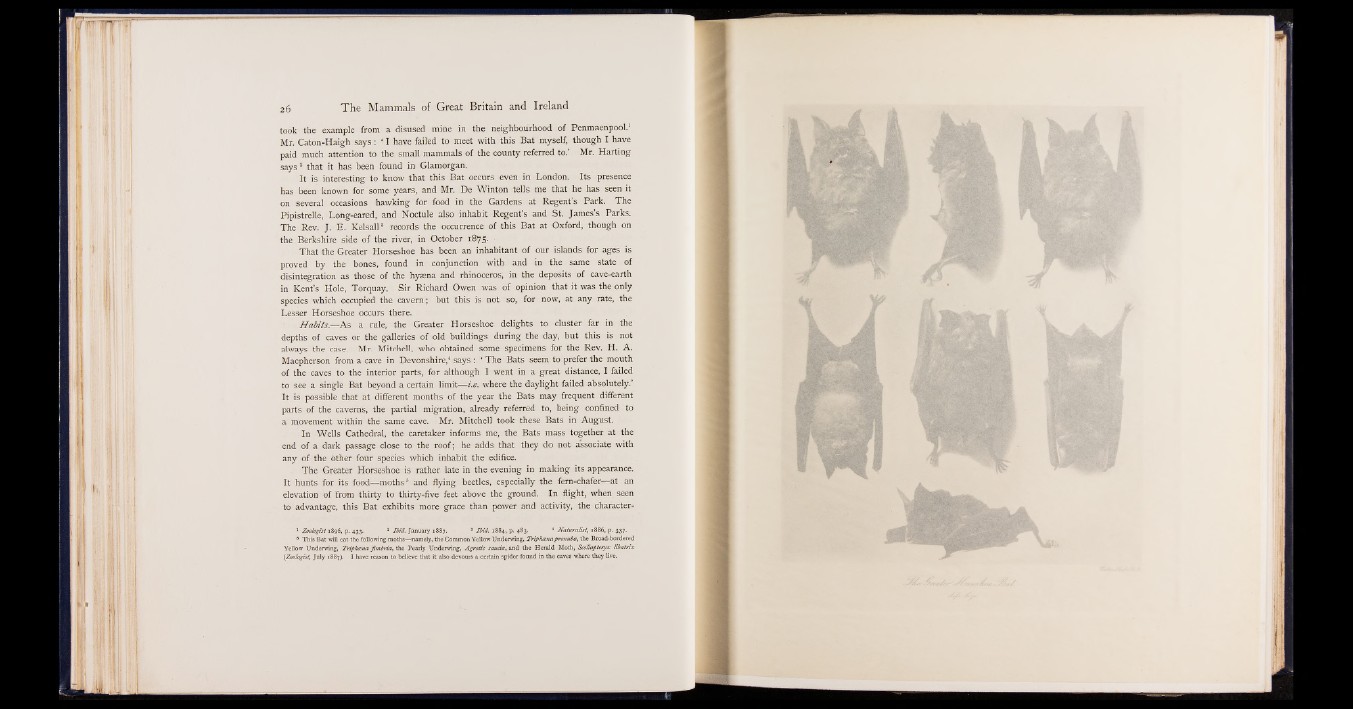
took the example from a disused mine in the neighbourhood of Penmaenpool.1
Mr. Caton-Haigh says: 4 1 have failed to meet with this Bat myself, though I have
paid much attention to the small mammals of the county referred to.’ Mr. Harting
says2 that it has been found in Glamorgan.
It is interesting to know that this Bat occurs even in London. Its presence
has been known for some years, and Mr. De Winton tells me that he has seen it
on several occasions hawking for food in the Gardens at Regent’s Park. The
Pipistrelle, Long-eared, and Noctule also inhabit Regent’s and St. James’s Parks.
The Rev. J. E. Kelsall8 records the occurrence of this Bat at Oxford, though on
the Berkshire side of the river, in October 1875.
That the Greater Horseshoe has been an inhabitant of our islands for ages is
proved by the bones, found in conjunction with and in the same state of
disintegration as those of the hyzena and rhinoceros, in the deposits of cave-earth
in Kent’s Hole, Torquay. Sir Richard Owen was of opinion that it was the only
species which occupied the cavern; but this is not so, for now, at any rate, the
Lesser Horseshoe occurs there.
Habits.— As a rule, the Greater Horseshoe delights to cluster far in the
depths of caves or the galleries of old buildings during the day, but this is not
always the case. Mr. Mitchell, who obtained some specimens for the Rev. H. A.
Macpherson from a cave in Devonshire,4 says : 4 The Bats seem to prefer the mouth
of the caves to the interior parts, for although I went in a great distance, I failed
to see a single Bat beyond a certain limit— i.e. where the daylight failed absolutely.’
It is possible that at different months of the year the Bats may frequent different
parts of the caverns, the partial migration, already referred to, being confined to
a movement within the same cave. Mr. Mitchell took these Bats in August.
In Wells Cathedral, the caretaker informs me, the Bats mass together at the
end of a dark passage close to the roof; he adds that they do not associate with
any of the other four species which inhabit the edifice.
The Greater Horseshoe is rather late in the evening in making its appearance.
It hunts for its food— moths" and flying beetles, especially the fern-chafer— at an
elevation of from thirty to thirty-five feet above the ground. In flight, when seen
to advantage, this Bat exhibits more grace than power and activity, the character-
1 Zoologist 1896, p. 433. * Ibid. January 1887. 3 Ibid. 1884, p. 483. * Naturalist, 1886, p. 337.
5 This Bat will eat the following moths—namely, the Common Yellow Underwing, Triphanapronuba, the Broad-bordered
Yellow Underwing, Triphana fimbria, the Pearly Underwing, Agrotis saucia, and the Herald Moth, Scoliapteryx Matrix
(Zoologist, July 1887). I have reason to believe that it also devours a certain spider found in the caves where they live.